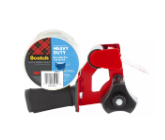Tape adhesives show up in more places than most people realize—automotive cabins, circuit boards, sterile packaging lines. But how they perform depends heavily on the conditions they’re exposed to. Heat, cold, moisture, solvents, and UV light all take a toll, and when adhesives give out, the consequences aren’t pretty.
Let’s break down how heat, cold, moisture, and chemicals can make or break adhesive performance.
Heat: How It Weakens Adhesive Bonds
High temperatures wreak havoc on most rubber-based adhesives. Around 50–60°C, they begin to soften. Beyond that, they can ooze, slip, or lose grip entirely. In fact, duct tape tested under moderate heat cycling (from 12°C to 75°C) gave up the ghost in just a few days.
If the application involves serious heat—think engine bays or electronics—look to materials like polyimide (Kapton®) or silicone adhesives, which are built for brutal thermal conditions. Some hold fast up to 400°C without melting down.
Cold, on the other hand, doesn’t melt adhesives—it freezes them. Below 0°C, many adhesives go rigid, losing flexibility and adhesion. But that doesn’t mean you’re out of options. Acrylic foams like 3M’s VHB 5900 series are made to work down to −60°C once set.
Key takeaway: Your tape’s job site temperature matters just as much as its specs. Don’t apply cold-bond tapes in freezing weather and expect miracles.
Humidity & Moisture: The Silent Saboteurs
Humidity doesn’t just sit in the air—it condenses on surfaces, forming a barrier that makes tape adhesion unreliable. Some adhesives even absorb moisture, turning gummy or weakening under stress.
Silicone-based and moisture-curing adhesives are the clear standouts in damp environments. If you’re working with medical applications, opt for breathable backings that let vapor escape—this helps avoid blistering and skin damage.
In industrial or packaging settings, avoid paper carriers and rubber adhesives in humid storage rooms or near loading docks. These can wrinkle or degrade over time.
Chemical Exposure: Handle With Care
Not all tapes are chemically tough. Rubber adhesives can swell, smear, or peel when exposed to fuels, oils, and cleaning agents. That makes them a poor choice for automotive or aerospace settings.
Acrylic and silicone adhesives, however, are built to resist solvents. For example, 3M transfer tapes are tested to hold up after soaking in gasoline and brake fluid.
Lesson: If it’s going to get splashed or scrubbed, don’t cheap out—go for a chemically resistant formulation.
UV Exposure: The Slow Breakdown of Adhesives
Ultraviolet light doesn’t show immediate damage—but it works slowly and relentlessly. Over time, UV breaks down both adhesive and backing, leading to discoloration, brittleness, and failed bonds.
If your tape sees any outdoor use, make sure it’s rated UV-stable. Clear packaging tapes with UV protection, or foil tapes with UV inhibitors, will last where rubber-based tapes yellow and peel.
Tape Performance by Category
📦 Duct Tape
-
Issues: Melts in heat, breaks down in solvents, delaminates over time.
-
Better picks: Foil-backed or silicone-based cloth tapes for HVAC and engine environments.
-
Challenges: Skin oils, moisture, and sensitivity.
-
Go with: Silicone adhesives for fragile skin; microporous acrylics for breathability and wear comfort.

-
Vulnerable to: Cold-induced brittleness, heat softening.
-
Ideal choice: Acrylic PSAs for heat and UV stability; cold-rated rubber adhesives for refrigerated shipping.
🛠 Industrial/High-Performance Tape
-
Used for: Structural bonding, heat masking, and electrical insulation.
-
Must haves: Polyimide, Kapton®, or foil with silicone or acrylic adhesives, especially in extreme heat or chemicals.
Sector-Specific Needs
Automotive
-
What it faces: Vibration, extreme heat, oils.
-
What works: Acrylic foam tapes, aluminum foil, and polyester films rated for 80°C+ and solvents.
Aerospace
-
The deal-breakers: Pressure shifts, flame ratings, and hydraulic fluids.
-
Your toolkit: Low-outgassing silicone adhesives, flame-retardant polyimide carriers.
Healthcare
-
The concern: Comfort, hygiene, biocompatibility.
-
Best options: Breathable silicone or acrylic tapes with low-residue removal and waterproof coatings for wet environments.
Best Practices for Reliable Adhesive Performance
-
Apply smart: Room temperature (~20°C) is the sweet spot for bonding.
-
Prep surfaces: Oil, dust, and moisture are bond killers.
-
Match to mission: Don't throw a general-purpose tape into a demanding role.
Wrapping It Up
Every environment leaves its mark. Whether it’s sweltering heat, freezing cold, drenching humidity, harsh chemicals, or prolonged UV exposure—your adhesive needs to be tough enough to take the hit.
If you’re serious about reliability, choose tape that’s built for the challenge—not just what’s on the shelf.
Resources for deeper dives:


